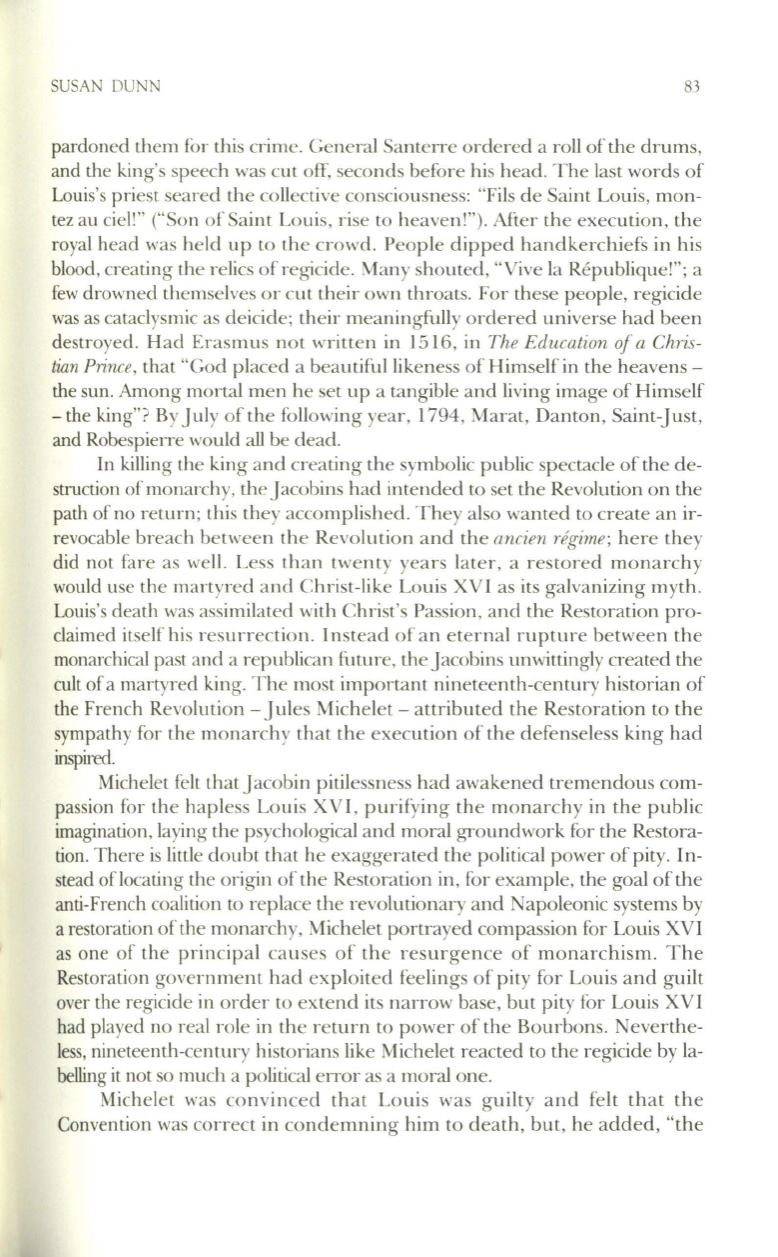
SUSAN DUNN
83
pardoned them for this crime. General Santerre ordered a roll of the drums,
and the king's speech was cut off, seconds before his head. The last words of
Louis's priest seared the collective consciousness: "Fils de Saint Louis, mon–
tez au ciell" ("Son of Saint Louis, rise to heaven!"). After the execution, the
royal head was held up to the crowd. People dipped handkerchiefs in his
blood, creating the relics of regicide. Many shouted, "Vive la Republique!"; a
few drowned themselves or cut their own throats. For these people, regicide
was as cataclysmic as deicide; their meaningfully ordered universe had been
destroyed . Had Erasmus not written in 1516, in
The Education of a Chris–
tian Prince,
that "God placed a beautiful likeness of Himself in the heavens -
the sun. Among mortal men he set up a tangible and living image of Himself
- the king"? By July of the following year, 1794, Marat, Danton, Saint-J ust,
and Robespierre would all be dead.
In killing the king and creating the symbolic public spectacle of the de–
struction of monarchy, the Jacobins had intended to set the Revolution on the
path of no return; this they accomplished. They also wanted to create an ir–
revocable breach between the Revolution and the
ancien regime;
here they
did not fare as well. Less than twenty years later, a restored monarchy
would use the martyred and Christ-like Louis XVI as its galvanizing myth.
Louis's death was assimilated with Christ's Passion, and the Restoration pro–
claimed itself his resurrection. Instead of an eternal rupture between the
monarchical past and a republican future, the Jacobins unwittingly created the
cult of a martyred king. The most important nineteenth-century historian of
the French Revolution - Jules Michelet - attributed the Restoration to the
sympathy for the monarchy that the execution of the defenseless king had
inspired.
Michelet felt thatJacobin pitilessness had awakened tremendous com–
passion for the hapless Louis XVI, purifying the monarchy in the public
imagination, laying the psychological and moral groundwork for the Restora–
tion. There is little doubt that he exaggerated the political power of pity. In–
stead oflocating the origin of the Restoration in, for example, the goal of the
anti-French coalition
to
replace the revolutionary and Napoleonic systems by
a restoration of the monarchy, Michelet portrayed compassion tor Louis XVI
as one of the principal causes of the resurgence of monarchism. The
Restoration government had exploited feelings of pity for Louis and gui lt
over the regicide in order to extend its narrow base, but pity for Louis XVI
had played no real role in the return to power of the Bourbons. Neverthe–
less, nineteenth-century historians like Michelet reacted to the regicide by la–
belling it not so much a political error as a moral one.
Michelet was convinced that Louis was guilty and felt that the
Convention was correct in condemning him
to
death, but, he added, "the


